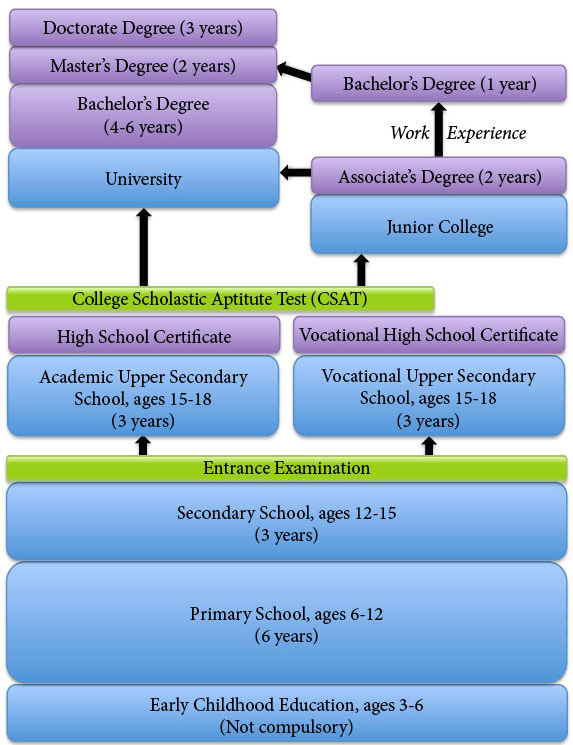
Understanding the South Korean Education System
The South Korean education system is renowned for its rigor and intensity, reflecting a cultural emphasis on academic excellence. With 12 years of compulsory education, the system is divided into primary, middle, and high school. Primary education lasts six years, followed by three years of middle school and three years of high school. Students typically enter high school between the ages of 17 to 19 in Korean age, which corresponds to 15 to 18 in international age. This structure is designed to prepare students for one of the most crucial examinations in their academic careers: the College Scholastic Ability Test (CSAT), a key determinant in college admissions. The CSAT is a comprehensive assessment that evaluates students in several subjects, including Korean language, mathematics, English, and history. Held annually in November, this exam is so vital that the government designates a national holiday to ensure students can focus without distractions. Success on the CSAT opens doors to prestigious universities, which play a significant role in shaping students’ future career prospects. The competition for high scores is fierce, and many students dedicate extensive time and effort to prepare for this pivotal test.
The College Scholastic Ability Test (CSAT)
The College Scholastic Ability Test, commonly known as Suneung, holds immense significance in South Korean society. This standardized exam is taken at the end of the high school career and is recognized as a critical factor in university admissions. The exam assesses knowledge in various subjects, with a focus on critical thinking and problem-solving skills. Given its importance, students often spend years preparing, attending additional classes and studying rigorously to achieve their desired scores. The impact of the CSAT extends beyond individual students; it shapes the educational landscape of South Korea. High scores on the CSAT can lead to admission into elite institutions such as Seoul National University and Korea University, which are highly regarded both nationally and internationally. The preparation for the CSAT is often accompanied by significant stress, as students feel the weight of societal expectations and the desire to secure a bright future.

Age Considerations in Education
Understanding age calculations in South Korea is essential for those unfamiliar with the local customs. In South Korea, students are considered one year older than their international age. For instance, a high school graduate is typically 20 in Korean age and 18 or 19 by international standards. This unique age system can create confusion for foreign students and parents, particularly when discussing educational milestones or planning academic paths. The age difference can also affect students’ experiences in the education system. Some may find themselves entering university later than peers due to various factors, such as retaking the CSAT or taking time off for personal interests. Understanding this cultural distinction is vital for effective communication and planning within the South Korean educational context.
The Role of Cram Schools (Hagwon)
Cram schools, known as hagwon, are an integral part of the South Korean education system. These private institutions provide supplementary lessons outside the regular school curriculum and are often attended by students seeking to improve their academic performance. Many students attend hagwon after their regular school hours, sometimes studying late into the night to keep up with the intense competition for university placements. The prevalence of hagwon reflects the societal pressure to excel academically. Students may feel compelled to attend these schools to gain an edge over their peers, leading to extended study hours and a demanding daily schedule. While hagwon can help students achieve their academic goals, they also contribute to a high-stress environment that can adversely affect mental health and well-being.
Academic Pressure and Mental Health
The intense focus on academic performance in South Korea has raised significant concerns regarding student mental health. With high competition levels, long study hours, and societal expectations to achieve top grades, many students experience chronic stress and anxiety. Reports of burnout and mental health issues among students are increasingly common, highlighting the need for comprehensive support systems within schools and communities. Recognizing these challenges, there is a growing movement advocating for mental health awareness and resources in educational settings. Schools are beginning to implement programs aimed at providing psychological support and promoting healthier study habits. Addressing the mental health crisis is crucial for ensuring that students can thrive both academically and personally, fostering a more balanced approach to education.
Extracurricular Activities and Social Life
Despite the demanding academic schedule, extracurricular activities play a vital role in the lives of South Korean students. Participation in clubs, sports, and cultural events can enhance personal development and foster social interactions. However, as students approach their final year of high school, the pressure to prepare for the CSAT often takes precedence, leading to a decline in participation in these enriching activities. This shift can result in a lack of social engagement during a critical stage of development. Students may struggle to balance their academic commitments with opportunities for personal growth and social interaction. Encouraging a well-rounded approach to education, which includes extracurricular involvement, is essential for nurturing students’ overall development, creativity, and interpersonal skills.
Opportunities for Early Graduation
South Korea offers various programs for gifted students, allowing them to graduate early and enter university ahead of their peers. These exceptional students can begin their college education at 19 in Korean age, or 17 to 18 internationally. Early graduation presents unique opportunities for talented individuals; however, it also raises concerns about the pressure placed on younger students to excel academically at an accelerated pace. While early graduation can benefit those who are ready for higher education, it is essential to consider the emotional and social implications of such decisions. Programs aimed at gifted students highlight the diversity within the educational landscape and the varying experiences of students. Balancing academic rigor with the developmental needs of younger learners is crucial for fostering a supportive educational environment.
The Future of Education in South Korea
As South Korea progresses, its education system faces ongoing challenges and opportunities for reform. The intense competition and high-pressure environment have led to calls for a shift toward more holistic educational approaches that prioritize creativity, critical thinking, and mental well-being. Educators and policymakers are increasingly recognizing the need to balance academic success with the overall health and happiness of students. Future reforms may focus on reducing the emphasis on rote memorization and standardized testing, encouraging innovative teaching methods that foster independent thinking and problem-solving skills. As societal values evolve, the education system may adapt to reflect these changes, ultimately benefiting future generations of students.
Conclusion: Navigating the South Korean Education System
Understanding the complexities of the South Korean education system is crucial for students and parents navigating this challenging landscape. From the significance of the CSAT to the pressures associated with hagwon, awareness of these factors can aid in making informed decisions about education and career paths. As the system continues to adapt to contemporary challenges, embracing a more balanced approach to education, which prioritizes mental well-being alongside academic success, may significantly benefit future generations of students.
